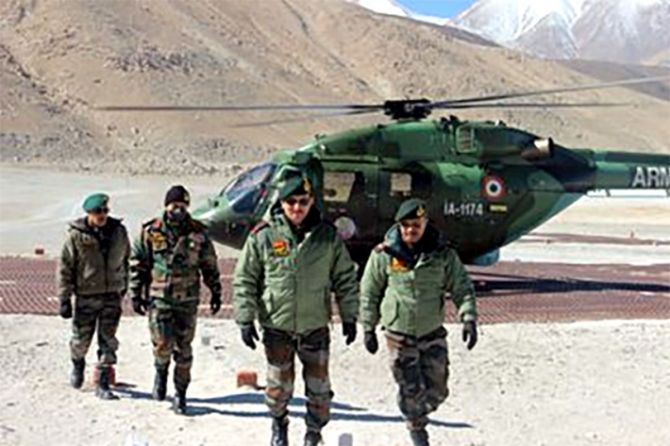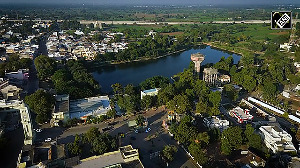India must break out of this strategic triangulation between China and Pakistan.
We need to settle our issues with one of the two, notes Shekhar Gupta.

The disengagement at Pangong Tso has been completed in quick time.
As new rounds of the corps commanders' talks begin, you could also guardedly hope that the larger de-escalation is now a possibility.
It's a good moment to pause to reflect on who's won and/or lost what as relative peace becomes a more likely prospect than war.
Our Northern Army Commander Lieutenant General Y K Joshi has already told us how close India and China were to a war during those fateful 48 hours when his troops climbed the dominating heights and key passes in the Pangong south bank and Kailash Range stretch west of Pangong-Moldo-Chushul.
A less reported event then was also the mountaineering-style climbs Indian units made on the higher reaches of the 'fingers' or the spurs on the north bank from where they looked down at the Chinese on the more comfortable lower ground.
It is also the oldest truism in mountain warfare that while lower may be more comfortable, it isn't preferable.
Not used to being taken by surprise, the Chinese tried to 'persuade' India to climb down.
The moves on the nights of 29 and 30 August last year, as part of the Indian Army's 'Operation Snow Leopard', had restored the tactical balance.
We had known more about what happened on the Rechin la, Mukhpari and Rezang la features on the southern bank and west of it.
But the even sharper exchanges higher up on the fingers, remained unreported for some time.
The viral picture of Chinese PLA soldiers armed with medieval spears and 'guandaos' -- traditional Chinese pole weapon, like a pole with a machete welded at the top - up, close and threatening Indian troops was from Mukhpari.
Three things had become clear by this time.
First, that Indian troops were not about to go away. They were as well-clothed, fed and armed as the Chinese and the heavier equipment was very well-maintained.
Second, that neither side wanted to escalate it into a skirmish.
Even at the narrow passes -- Rechin La is no more than a couple of hundred metres wide, the two sides deployed tanks within feet of each other.
Like India-Pakistan sentries at the Wagah Border outpost.
Tanks don't fight that close. Even horse cavalries never got that close before the beginning of fighting.
It was a mere show of strength and a traffic block at my end, just in case you chose to come for a drive.
When -- and if -- all this is over, we will look back at these pictures and laugh at the ridiculous spectacle of the world's two largest nations loaded with nuclear arsenals, confronting each other with tanks so close as if poised for head-butting.
And third, that it was now a battle of attrition, fought with the weather, altitude, terrain and logistics.
And the hardiness of the soldier on rival sides. The question was, let's see who can last the winter in large numbers here.
The fact is, both did. It is then that the Chinese became amenable to de-escalation.
Of course, the international and economic moves, rise of the Quad, Joe Biden's ringing endorsement of it, India dumping its hesitations of its strategic history and a strengthening grouping of China's victims, which I sometimes describe as "Cheen Peedit Samaj", also played a role.
On de-escalation, India and China have flattered to deceive more than once in the past nine months.
So, predicting the outcome of this peace-making process, the most promising so far, is about as hazardous as betting on who will win in West Bengal this April.
Both countries now have public opinion and social media jingoism as an additional escalatory challenge.
We see it in India with our commando-comic channels and Twitter.
But, as China expert and a senior editor at The Hindu, Ananth Krishnan, points out, even Weibo, the Chinese equivalent of Twitter, is buzzing with fury, particularly after the rival claims of Chinese casualties in Galwan.
Both countries have the compulsion to tell their domestic constituencies they won.
This will cast a shadow in the coming rounds of talks.
We can, however, try a more clinical analysis purely at the geostrategic level.
Our knowledge is limited by the fact that we are still not sure why the Chinese came knocking at our doors so rudely in Ladakh last year.
Educated guesswork ranges from their wanting to convey a message after Article 370 was rendered inoperative and Ladakh declared a union territory at the one end, to repositioning India strategically from the Indian Ocean back to its land frontiers, and dissuading it from getting too close to America in the new Cold War.
It could be a combination of all three. Did the Chinese achieve any of these?
As we stand today, India is closer to the new US-led block against China and is probably the most important non-treaty bound nation there.
Second, India and the other three, US, Japan and Australia, now seem even more firmly committed to the Quad.
For removal of all doubts, check out the readouts of the four foreign ministers' meeting.
There were many, mostly the old conservatives, who grew in the decades of the Cold War who had hoped that once the Chinese were off our throats, India will distance itself from the Quad.
This was naive in the extreme.
This brings us to areas where we do not have such clarity.
How will this affect the strategic outlook to which India has evolved in the 21st Century?
China's 2013 strategy paper, which just came into international attention as a US air force think-tank published it in full in English, tells us what the Chinese think.
They believe that with the economic boom post-1991, India now sees itself as more than a regional power and wants influence southwards into the Indian Ocean Region.
That is because, the paper argues, India now feels secure on its land borders and rules out a war.
Has this Ladakh excursion by PLA changed that? By reminding India that its two-front land border threat has not gone away?
Will we now see India shift focus away from the navy to land forces? We will know that in a year or so.
But if that happens, it will be a Chinese gain.
Similarly, through these nine fraught months, nobody who counts on the Indian side has talked of taking back Aksai Chin.
Don't be surprised if none does in some time to come.
If that was China's message, it has gone home. But I am not convinced they will go on such a dangerous adventure only for this.
Finally, see the picture from India's interest.
For decades, our strategic thinkers have worried about the two-front situation.
India can expand its defence budget, become a national security State like Pakistan (I hope not), the prospect of a two-front war is a nightmare, and winning it a fantasy.
That's why the big challenge for Indian political and strategic leadership is to avoid it.
Which brings us back to the old imperative: That India must break out of this strategic triangulation between China and Pakistan.
And then the question: How to do it?
We need to settle our issues with one of the two.
That's why all our earlier governments made serious moves to make peace with China.
But it is more logical to settle your problems with the country weaker than you, with more to gain from peace.
That hasn't worked. And now there is an additional problem.
This government is our most political of all in the sense it weighs all policy in electoral terms.
If so, it would need hostility with Pakistan to persist.
Because Pakistan and pan-Islamic terrorism are the warp and weft in which electoral polarisation at home comes gift-wrapped.
That is the fundamental issue the Modi government will need to weigh.
Will it let domestic political compulsions limit its strategic options, or have the confidence to change? Of course, it could do something more audacious and settle with China first.
But then, we know who's the stronger party in that negotiation.
By Special Arrangement with The Print
Feature Presentation: Aslam Hunani/Rediff.com











